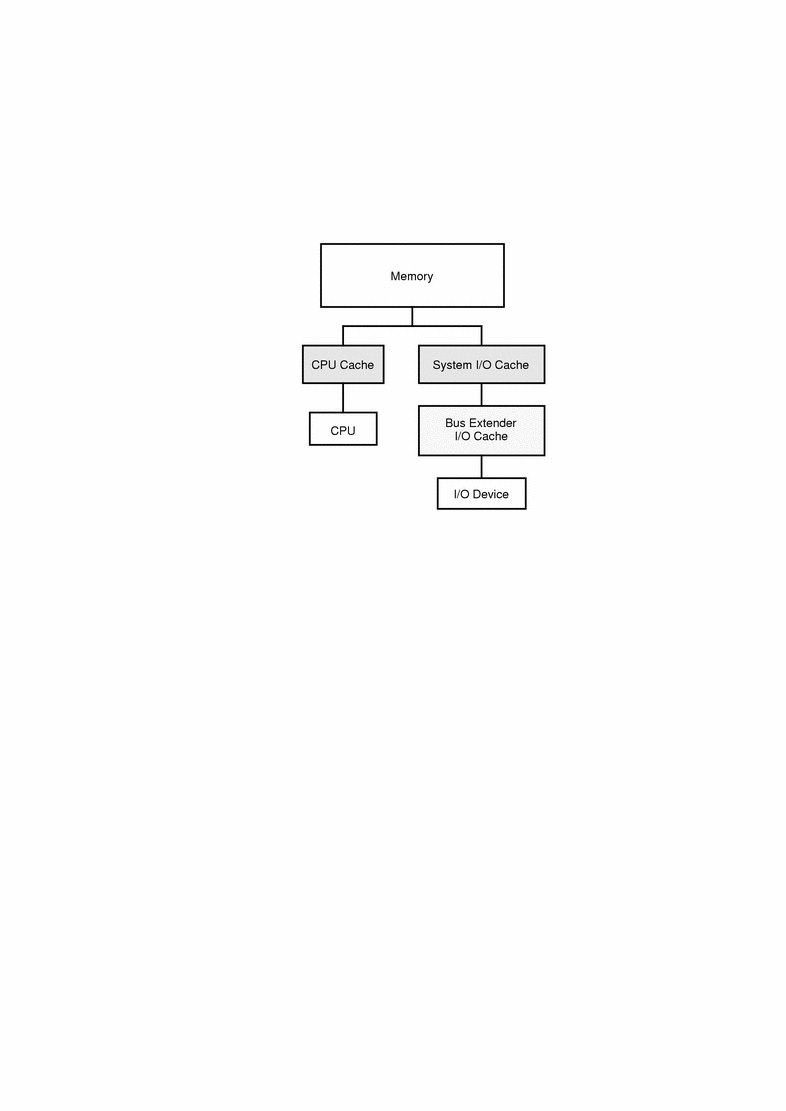Synchronizing Memory Objects
At various points when the memory object is accessed (including the time of removal of the DMA resources), the driver may need to synchronize the memory object with respect to various caches. This section gives guidelines on when and how to synchronize memory objects.
Cache
Cache is a very high-speed memory that sits between the CPU and the system's main memory (CPU cache), or between a device and the system's main memory (I/O cache), as shown in Figure 7-1.
Figure 7-1 CPU and System I/O Caches

When an attempt is made to read data from main memory, the associated cache first determines whether it contains the requested data. If so, it quickly satisfies the request. If the cache does not have the data, it retrieves the data from main memory, passes the data on to the requestor, and saves the data in case that data is requested again.
Similarly, on a write cycle, the data is stored in the cache quickly and the CPU or device is allowed to continue executing (transferring). This takes much less time than it otherwise would if the CPU or device had to wait for the data to be written to memory.
An implication of this model is that after a device transfer has been completed, the data may still be in the I/O cache but not yet in main memory. If the CPU accesses the memory, it may read the wrong data from the CPU cache. To ensure a consistent view of the memory for the CPU, the driver must call a synchronization routine to write the data from the I/O cache to main memory and update the CPU cache with the new data. Similarly, a synchronization step is required if data modified by the CPU is to be accessed by a device.
There may also be additional caches and buffers in between the device and memory, such as caches associated with bus extenders or bridges. ddi_dma_sync(9F) is provided to synchronize all applicable caches.
ddi_dma_sync()
If a memory object has multiple mappings--such as for a device (through the DMA handle), and for the CPU--and one mapping is used to modify the memory object, the driver needs to call ddi_dma_sync(9F) to ensure that the modification of the memory object is complete before accessing the object through another mapping. ddi_dma_sync(9F) may also inform other mappings of the object that any cached references to the object are now stale. Additionally, ddi_dma_sync(9F) flushes or invalidates stale cache references as necessary.
Generally, the driver has to call ddi_dma_sync(9F) when a DMA transfer completes. The exception to this is that deallocating the DMA resources (ddi_dma_unbind_handle(9F)) does an implicit ddi_dma_sync(9F) on behalf of the driver.
int ddi_dma_sync(ddi_dma_handle_t handle, off_t off, size_t length, u_int type);
If the object is going to be read by the DMA engine of the device, the device's view of the object must be synchronized by setting cttype to DDI_DMA_SYNC_FORDEV. If the DMA engine of the device has written to the memory object, and the object is going to be read by the CPU, the CPU's view of the object must be synchronized by setting type to DDI_DMA_SYNC_FORCPU.
Here is an example of synchronizing a DMA object for the CPU:
if (ddi_dma_sync(xsp->handle, 0, length, DDI_DMA_SYNC_FORCPU)
== DDI_SUCCESS) {
/* the CPU can now access the transferred data */
...
} else {
error handling
}
If the only mapping that concerns the driver is one for the kernel (such as memory allocated by ddi_dma_mem_alloc(9F)), the flag DDI_DMA_SYNC_FORKERNEL can be used. This is a hint to the system that if it can synchronize the kernel's view faster than the CPU's view, it can do so; otherwise, it acts the same as DDI_DMA_SYNC_FORCPU.
- © 2010, Oracle Corporation and/or its affiliates
